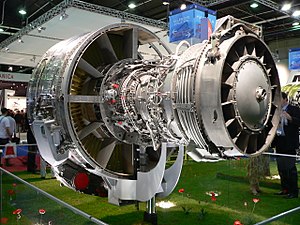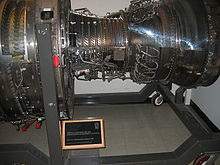CFM International CFM56
| CFM56 | |
|---|---|

| |
| CFM56-5 | |
| Type | Turbofan |
| National origin | France and United States |
| Manufacturer | CFM International |
| First run | 1970s |
| Major applications | Airbus A320 family Boeing 737 Classic Boeing 737 Next Generation KC-135R Stratotanker |
| Number built | 13,000+ |
| Developed from | General Electric F101 |
| Developed into | CFM International LEAP-X |


CFM International CFM56 series engines (US military designation F108) are a family of high-bypass turbofan engines made by CFM International with a thrust range from 18,500 to 34,000 lbf (82 kN to 151 kN). CFM International is a 50-50 joint company of Snecma, France and GE Aviation, U.S.A. Both companies are responsible for producing various components, with each having their own final assembly line. GE is responsible for the high pressure compressor, combustor and high pressure turbine, while Snecma is responsible for the fan, low pressure turbine, the gearbox and the exhaust. The engines are assembled by GE in Evendale, Ohio, USA and by Snecma in Villaroche, France.
The CFM56 is one of the most prolific engine types in the world because of its long history starting with the Boeing 737-300. The 737 family has solely relied on the CFM56 for more than 25 years, and the CFM56 still powers the newest variants, the 737-900ER and 737-700ER. The engine is also an option on Airbus A320 family. It is also the sole powerplant of the A340-200 & -300. The F108 replaced the Pratt & Whitney JT3D engines on the KC-135 Stratotanker in the 1980s to create the KC-135R, achieving a 27% fuel savings.[1]
Variants
The CFM56 powers short-, medium- and long-range aircraft. Its core turbomachinery is based on General Electric's F101 engine, which was developed for the B-1B Lancer strategic bomber. It entered service in 1982 and there are now 13,000 CFM56 engines of all types in service.[2]
CFM56-2 series
This is the earliest of the series with a thrust range of between 22,000 to 24,000 lbf (98 kN to 108 kN). It first appeared in the re-engined Douglas DC-8 Super 70 in 1982. Its success led to it re-engining military variants of Boeing 707. F108 is the engine's U.S. military designation. Today, the U.S. Air Force is CFM's largest customer, with more than 450 re-engined aircraft in service, or 1,800 CFM56-2 engines. This does not include later CFM56 variants on USAF and U.S. Navy 737 airframes. The CFM56-2 comprises a single stage fan, with a three-stage IP compressor, driven by a four-stage LP turbine, supercharging a nine-stage HP compressor, driven by a single stage, high work, HP turbine. The combustor is annular. Leading particulars for the CFM56-2C are bypass ratio of 6.0 and an overall pressure ratio of 24.7. The 68.3in diameter fan has an airflow of 788lb/s. The engine develops 22,000-24,000 lbf of static thrust.
CFM56-3 series

The first derivative of the CFM56 series, the CFM56-3 was designed for Boeing 737-300/-400/-500 series aircraft, with static thrust ratings from 18,500 to 23,500 lbf (82 kN to 105 kN). A cropped fan derivative of the -2, the -3 engine has a smaller 60in fan diameter and lower bypass ratio, but retains the original basic engine layout.
A significant challenge for this series was the size of the wing-mounted engine for ground clearance. This was partially overcome by mounting the accessories at the lower corners, and flattening the nacelle bottom and intake lip, thus giving a distinctive appearance of the Boeing 737 with CFM56 engines. The engines were also moved forward and raised, with the top nacelle surface essentially level with the upper surface of the wing, and tilted 5 degrees up. This not only helped increase the ground clearance but also directed the exhaust downwards which reduced the effects of pylon overheating and gave some vectored-thrust effect, assisting take-off performance.[citation needed]
It was first certified by the US Federal Aviation Administration in January 1984. It became the most numerous turbofan variant in aviation history with 3,975 engines produced for the 737-300/-400/-500. It is very reliable and has a high resale value.
Following the Kegworth air disaster of 1989, due to metal fatigue causing compressor failure in the engine, the entire 737-400 fleet was temporarily grounded.
Leading particulars for the -3B1 are bypass ratio 5.0, overall pressure ratio 27.5, airflow 655lb/s, static thrust 20000 lbf.
CFM56-5 series
The CFM56-5 series is designed for the Airbus aircraft. It has a very wide thrust rating of between 22,000 to 34,000 lbf (98 kN to 151 kN). It differs from its Boeing fitted cousins by features such as FADEC, advanced internal design giving improved performance over the CFM56-3 whilst maintaining the CFM56-3 reliability. It has 3 distinct sub-variants, the CFM56-5A, CFM56-5B and CFM56-5C. Both the CFM56-5A and CFM56-5B are ETOPS rated. The Airbus designator for any aircraft equipped with CFM engines is "1"; eg. A320-211 or A340-312.
CFM56-5A series
CFM56-5A series is designed to power the short-to-medium range Airbus A320 family, with thrusts between 22,000 to 26,500 lbf (98 kN to 118 kN). This is the initial CFM56-5 series. Its design is derived from the CFM56-2 and CFM56-3 families. Mechanical arrangement and fan diameter as -2C.
Leading particulars for the 5/A1 are: bypass ratio 6.0, overall pressure ratio 31.2, airflow 852lb/s, static thrust 25000 lbf.
CFM56-5B series
An improvement of the CFM56-5A series, it was originally designed to power the A321. Today, it powers every model in the A320 family (A318/A319/A320/A321), and has superseded the CFM56-5A series. Among the change over the CFM56-5A is the double annular combustor technology which reduces oxides of nitrogen emission by as much as 45 percent. It is also the most numerous engine supplied to Airbus. The thrust range is between 22,000 to 33,000 lbf (98 kN to 147 kN).
Mechanical arrangement and fan diameter as -5A, but with a 4th stage added to the IP compressor. Leading particulars for the 5/B1 are: bypass ratio 5.5, overall pressure ratio 35.4, airflow 943lb/s, net thrust 30000lbf.
CFM56-5C series
With thrust rating of between 31,200 to 34,000 lbf (139 kN to 151 kN), CFM56-5C series is the most powerful of the CFM56 family. It powers Airbus' long-range A340-200 and -300 airliners, and entered service in 1993. A fifth stage was added to the LP turbine.
For the A340, CFM International supplies the CFM56-5C series as a total propulsion system: engine, nacelle, and exhaust systems as opposed to just bare engines of the other variants.
Its exhaust design features a mixer with integrated nozzle for better efficiency (this design is also found in IAE V2500 series and on some RB211 series) and it also features a unique 'petal' thrust reversers rather than the conventional cascade design. This is due to the A340 requirements of maximum range and efficiency.
Leading particulars for the -5/C2 are: bypass ratio 6.6, overall pressure ratio 37.4, airflow 1027lb/s, net thrust 31200lbf.
CFM56-7 series
The CFM56-7 powers the Boeing 737 Next Generation series (737-600/-700/-800/-900). The CFM56-7 is rated with takeoff thrust from 18,500 to 27,300 lbf (82 kN to 121 kN).
It has higher thrusts, improved efficiency, and lower maintenance costs than its predecessor, the CFM56-3 series. It incorporates many features from the CFM56-5 series such as FADEC, double annular combustor and improved internal design. Mechanical arrangement is as in -3 series, but the fan diameter is increased to 61.0in.
The CFM56-7-powered 737 is granted 180-minute Extended-Range, Twin-Engine Operations (ETOPS) approval by the U.S. Federal Aviation Administration. It also powers the military versions of the Next-Generation 737, the C-40 Clipper, the P-8 Poseidon, and Boeing 737 AEW&C.
Leading particulars for the -7/B18 are: bypass ratio 5.5, overall pressure ratio 32.7, airflow 677lb/s, net thrust 19500lbf.
The CFM56-5B/5C/7 use essentially the same HP core. HP parts are dimensionally identical among the 5B/5C/7 although may or may not have different part numbers (source is ESM - Engine Shop Manual). Double annular combustor (DAC) is minority; most engines are SAC.
Applications
- Airbus A320 family
- Airbus A340
- Boeing 707-700 (prototype only)
- Boeing 737 Classic
- Boeing 737 Next Generation
- Boeing 737 AEW&C
- Boeing Business Jet
- C-40 Clipper
- Douglas DC-8 Super 70
- KC-135R Stratotanker
- P-8 Poseidon
Specifications
| This aircraft engine article is missing some (or all) of its specifications. If you have a source, you can help Wikipedia by adding them. |
See also
Related development
Related lists
